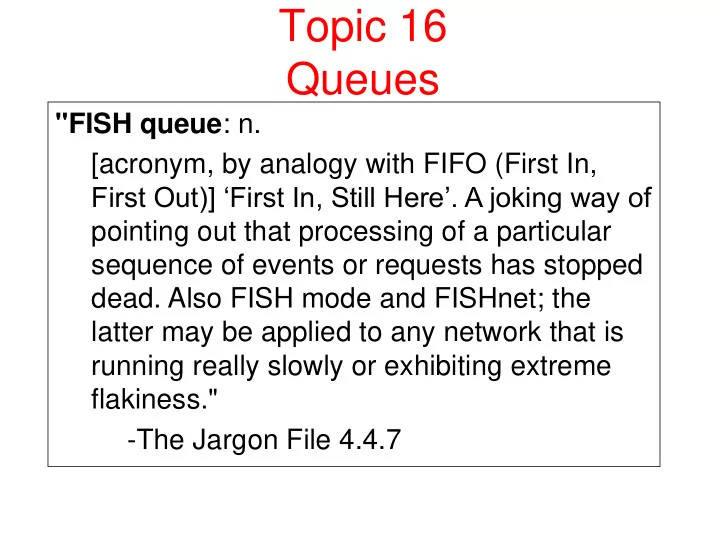

Topic 16 Queues "FISH queue : n. [acronym, by analogy with FIFO (First In, First Out)] ‘First In, Still Here’. A joking way of pointing out that processing of a particular sequence of events or requests has stopped dead. Also FISH mode and FISHnet; the latter may be applied to any network that is running really slowly or exhibiting extreme flakiness." -The Jargon File 4.4.7
Queues A sharp tool, like stacks A line –In England people don’t “get in line” they “queue up”. CS314 2 Queues
Queue Properties Queues are a first in first out data structure – FIFO (or LILO, but that sounds a bit silly) Add items to the end of the queue Access and remove from the front – Access to the element that has been in the structure the longest amount of time Used extensively in operating systems – Queues of processes, I/O requests, and much more CS314 3 Queues
Queues in Operating Systems On a computer with N cores on the CPU, but more than N processes, how many processes can actually be executing at one time? One job of OS, schedule the processes for the CPU CS314 4 Queues
Queue operations enqueue(E item) – a.k.a. add(E item) E front() – a.k.a. E peek() E dequeue() – a.k.a. E remove() boolean isEmpty() Specify methods in an interface, allow multiple implementations. CS314 5 Queues
Queue interface, version 1 public interface Queue<E> { //place item at back of this Queue enqueue(E item); //access item at front of this Queue //pre: !isEmpty() E front(); //remove item at front of this Queue //pre: !isEmpty() E dequeue(); boolean isEmpty(); } CS314 6 Queues
Implementing a Queue Given the internal storage container and choice for front and back of queue what are the Big O of the queue operations? ArrayList LinkedList LinkedList (Singly Linked) (Doubly Linked) enqueue front dequeue isEmpty CS314 7 Queues
Clicker 1 If implementing a queue with a singly linked list with references to the first and last nodes (head and tail) which end of the list should be the front of the queue in order to have all queue operations O(1)? A. The front of the list should be the front of the queue. B. The back of the list should be the front of the queue. C. Either end will work to make all ops O(1). D. Neither end will allow all ops to be O(1). CS314 8 Queues
Alternate Implementation How about implementing a Queue with a native array? – Seems like a step backwards CS314 9 Queues
Application of Queues Radix Sort – radix is a synonym for base. base 10, base 2 Multi pass sorting algorithm that only looks at individual digits during each pass Use queues as buckets to store elements Create an array of 10 queues Starting with the least significant digit place value in queue that matches digit empty queues back into array repeat, moving to next least significant digit CS314 10 Queues
Radix Sort in Action: 1s original values in array 9, 113, 70, 86, 12, 93, 37, 40, 252, 7, 79, 12 Look at ones place 9, 113, 70, 86, 12, 93, 37, 40, 252, 7, 79, 12 Queues: 0 70, 40 5 1 6 86 2 12, 252, 12 7 37, 7 3 113, 93 8 4 9 9, 79 CS314 11 Queues
Radix Sort in Action: 10s Empty queues in order from 0 to 9 back into array 70, 40, 12, 252, 12, 113, 93, 86, 37, 7, 9, 79 Now look at 10's place 70, 40, 12, 252, 12, 113, 93, 86, 37, 7, 9, 79 Queues: 0 7, 9 5 252 1 12, 12, 113 6 2 7 70, 79 3 37 8 86 4 40 9 93 CS314 12 Queues
Radix Sort in Action: 100s Empty queues in order from 0 to 9 back into array 7, 9, 12, 12, 113, 37, 40, 252, 70, 79, 86, 93 Now look at 100's place __7, __9, _12, _12, 113, _37, _40, 252, _70, _79, _86, _93 Queues: 0 7, 9, _12, _12, _37, _40, _70, _79, _86, _93 5 1 113 6 2 252 7 3 8 4 9 CS314 13 Queues
Radix Sort in Action: Final Step Empty queues in order from 0 to 9 back into array 7, 9, 12, 12, 40, 70, 79, 86, 93, 113, 252 CS314 14 Queues
Radix Sort Code public static void sort(int[] list){ ArrayList<Queue<Integer>> queues = new ArrayList<Queue<Integer>>(); for(int i = 0; i < 10; i++) queues.add( new LinkedList<Integer>() ); int passes = numDigits(list[0]); // helper method // or int passes = (int) Math.log10(list[0]); for(int i = 1; i < list.length; i++){ int temp = numDigits(list[i]); if( temp > passes ) passes = temp; } for(int i = 0; i < passes; i++){ for(int j = 0; j < list.length; j++) queues.get(valueOfDigit(list[j], i)).add(list[j]); int pos = 0; for(Queue<Integer> q : queues){ while(!q.isEmpty()) list[pos++] = q.remove(); } } } CS314 15 Queues
Recommend
More recommend